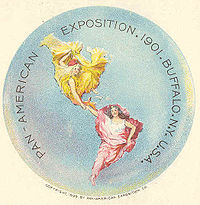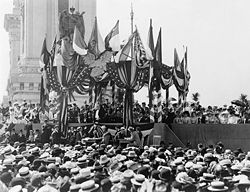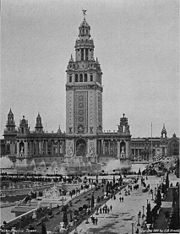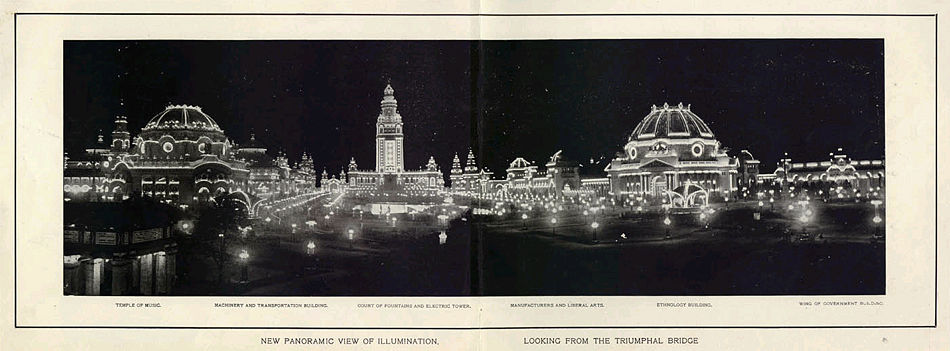
Pan-American Exposition
Encyclopedia

Buffalo, New York
Buffalo is the second most populous city in the state of New York, after New York City. Located in Western New York on the eastern shores of Lake Erie and at the head of the Niagara River across from Fort Erie, Ontario, Buffalo is the seat of Erie County and the principal city of the...
, United States
United States
The United States of America is a federal constitutional republic comprising fifty states and a federal district...
, from May 1 through November 2, 1901. The fair occupied 350 acres (1.4 km²) of land on the western edge of what is present day Delaware Park
Delaware Park
Delaware Park-Front Park System is a historic park system and national historic district located in the northern and western sections of Buffalo in Erie County, New York...
, extending from Delaware Ave. to Elmwood Ave and northward to Great Arrow Ave.
History
The event was organized by the Pan-American Exposition Company, formed in 1897. Cayuga IslandCayuga Island
Cayuga Island is a small island in the Niagara River, in Niagara County, N.Y., a few miles upstream of the Niagara Falls.Cayuga Creek empties into the river on the north side of the island. It is part of the LaSalle area of Niagara Falls, New York. It consists of middle class housing and a city...
was initially chosen as the place to hold the Exposition because of the island's proximity to Niagara Falls
Niagara Falls
The Niagara Falls, located on the Niagara River draining Lake Erie into Lake Ontario, is the collective name for the Horseshoe Falls and the adjacent American Falls along with the comparatively small Bridal Veil Falls, which combined form the highest flow rate of any waterfalls in the world and has...
, which was a huge tourist attraction. But when the Spanish-American War
Spanish-American War
The Spanish–American War was a conflict in 1898 between Spain and the United States, effectively the result of American intervention in the ongoing Cuban War of Independence...
broke out in 1898, plans were put on hold. After the war, there was a heated competition between Buffalo and Niagara Falls
Niagara Falls, New York
Niagara Falls is a city in Niagara County, New York, United States. As of the 2010 census, the city had a total population of 50,193, down from the 55,593 recorded in the 2000 census. It is across the Niagara River from Niagara Falls, Ontario , both named after the famed Niagara Falls which they...
over the location. Buffalo won for two main reasons. First, Buffalo had a much larger population — with roughly 350,000 people, it was the eighth-largest city in the United States. Second, Buffalo had better railroad connections — the city was within a day's journey by rail for over 40 million people. In July 1898, Congress pledged $500,000 for the Exposition to be held at Buffalo. The "Pan American" theme was carried throughout the event with the slogan "commercial well being and good understanding among the American Republics." Nikola Tesla
Nikola Tesla
Nikola Tesla was a Serbian-American inventor, mechanical engineer, and electrical engineer...
had recently invented a three-phase system
Three-phase electric power
Three-phase electric power is a common method of alternating-current electric power generation, transmission, and distribution. It is a type of polyphase system and is the most common method used by grids worldwide to transfer power. It is also used to power large motors and other heavy loads...
of alternating current
Alternating current
In alternating current the movement of electric charge periodically reverses direction. In direct current , the flow of electric charge is only in one direction....
power transmission for distant transfer of electricity. This allowed designers to light the Exposition in Buffalo using power generated 25 miles (40 km) away at Niagara Falls
Niagara Falls
The Niagara Falls, located on the Niagara River draining Lake Erie into Lake Ontario, is the collective name for the Horseshoe Falls and the adjacent American Falls along with the comparatively small Bridal Veil Falls, which combined form the highest flow rate of any waterfalls in the world and has...
.
Key Events

United States
The United States of America is a federal constitutional republic comprising fifty states and a federal district...
President
President of the United States
The President of the United States of America is the head of state and head of government of the United States. The president leads the executive branch of the federal government and is the commander-in-chief of the United States Armed Forces....
William McKinley
William McKinley
William McKinley, Jr. was the 25th President of the United States . He is best known for winning fiercely fought elections, while supporting the gold standard and high tariffs; he succeeded in forging a Republican coalition that for the most part dominated national politics until the 1930s...
was assassinated
William McKinley assassination
The assassination of William McKinley occurred on September 6, 1901, inside the Temple of Music located on the grounds of the 1901 Pan-American Exposition in Buffalo, New York...
by an anarchist
Anarchism
Anarchism is generally defined as the political philosophy which holds the state to be undesirable, unnecessary, and harmful, or alternatively as opposing authority in the conduct of human relations...
, Leon Czolgosz
Leon Czolgosz
Leon Czolgosz was the assassin of U.S. President William McKinley.In the last few years of his life, he claimed to have been heavily influenced by anarchists such as Emma Goldman and Alexander Berkman.- Early life :...
, at the Temple of Music
Temple of Music
The Temple of Music was a concert hall and auditorium built for the Pan-American Exposition which was held in Buffalo, New York, in 1901. U.S. President William McKinley was assassinated inside the building on September 6, 1901...
on September 6, 1901; the President died 8 days later. McKinley had given an address at the exposition the previous day; his speech included the following words:
Expositions are the timekeepers of progress. They record the world's advancements. They stimulate the energy, enterprise, and intellect of the people, and quicken human genius. They go into the home. They broaden and brighten the daily life of the people. They open mighty storehouses of information to the student....
The newly-developed X-ray machine
X-ray machine
An X-ray generator is a device used to generate X-rays. These devices are commonly used by radiographers to acquire an x-ray image of the inside of an object but they are also used in sterilization or fluorescence....
, which was an invention of Thomas Edison, was displayed at the fair, but doctors were reluctant to use it on McKinley to search for the bullet because they did not know what side effects it may have had on him. When they did eventually attempt to use it, it appeared be missing a key component, and much to Edison's embarrassment, failed to work. Also, ironically, the operating room at the exposition's emergency hospital did not have any electric lighting
Incandescent light bulb
The incandescent light bulb, incandescent lamp or incandescent light globe makes light by heating a metal filament wire to a high temperature until it glows. The hot filament is protected from air by a glass bulb that is filled with inert gas or evacuated. In a halogen lamp, a chemical process...
, even though the exteriors of many of the buildings were covered with thousands of light bulbs. Doctors used a pan to reflect sunlight onto the operating table as they treated McKinley's wounds.

Notable Buildings/Exhibits
- The Administration Building
- The Agricultural, Machinery, Manufacturers, and Liberal Arts Buildings designed by George ShepleyGeorge Foster Shepley (architect)George Foster Shepley was an architect in the firm Shepley, Rutan and Coolidge, the successor to the firm of architect H.H. Richardson. He was educated at the Massachusetts Institute of Technology, graduating in its class of 1882. Shepley married H.H. Richardson's daughter....
. - The Electric Tower (the fair's center piece) designed by John Galen HowardJohn Galen HowardJohn Galen Howard was an American architect.He is best known for his work as the supervising architect of the Master Plan for the University of California, Berkeley campus, and for founding the University of California's architecture program...
. - The Electricity Building designed by Green & WicksEdward Brodhead GreenE. B. Green was a major American architect from New York State. He was born in Utica, NY. He attended Cornell University, and moved to Buffalo, NY in 1881, where he was active through about 1930...
. - The Ethnology Building designed by George Cary.
- The Government Building designed by J.K Taylor.
- The Mines, Graphic Arts, and Horticulture Buildings all designed by R.S. Peabody.
- The New York State Building designed by George Cary and constructed of Vermont Marble.
- The Temple of MusicTemple of MusicThe Temple of Music was a concert hall and auditorium built for the Pan-American Exposition which was held in Buffalo, New York, in 1901. U.S. President William McKinley was assassinated inside the building on September 6, 1901...
which served as the center for the live performances. Designed by Esenwein & JohnsonJames A. Johnson (architect)James Addison Johnson was a Buffalo, New York architect known for his design of various architectural landmarks and his use of decorative work that many consider a foreshadowing of art deco design....
. - The Woman's Building
Attractions
- The Court of Fountains, the central court to the exposition.
- The Great Amphitheater
- The Triumphal Bridge, which was positioned over the "Mirror Lake"
Legacy
When the fair ended, most of the buildings were demolished and the grounds were cleared and subdivided to be used for residential streets. Similar to previous world fairs a majority of the buildings were constructed of timber and steel framing with precast staffStaff (building material)
Staff is a kind of artificial stone used for covering and ornamenting buildings.Staff is chiefly made of powdered gypsum or plaster of Paris, with a little cement, glycerin, and dextrin, mixed with water until it is about as thick as molasses, when staff is cast in molds it can form any shape...
panels made of a plaster/fiber mix. These buildings were built as a means of rapid construction and temporary ornamentation and not made to last.
A boulder marking the site of McKinley's assassination was placed in a grassy median on Fordham Drive in Buffalo.
The New York State building, was designed to permanently outlast the Exposition and is used by the Buffalo and Erie County Historical Society
Buffalo and Erie County Historical Society Building
The Buffalo and Erie County Historical Society is located on Nottingham Court in the city of Buffalo, just east of Elmwood Avenue, north of the Scajaquada Expressway, in the northwest corner of Delaware Park. It occupies the building constructed in 1901 as the New York State pavilion for that...
, located in Delaware Park, as a museum. Designated a National Historic Landmark
National Historic Landmark
A National Historic Landmark is a building, site, structure, object, or district, that is officially recognized by the United States government for its historical significance...
in 1987, it can be visited on Nottingham Court. The Albright-Knox Art Gallery
Albright-Knox Art Gallery
The Albright-Knox Art Gallery is an art museum located in Delaware Park in Buffalo, New York. The gallery is a major showplace for modern art and contemporary art. It is located directly across the street from Buffalo State College.-History:...
was intended to be used as a Fine Arts Pavilion but delays in its construction saw it uncompleted in time. The original Electric Tower although destroyed, survives in part as the 13 story, Beaux-Arts Electric Tower
Electric Tower
Electric Tower, or General Electric Tower, is a historic office building and skyscraper located at Buffalo in Erie County, New York. It is the seventh tallest building in Buffalo. It stands and 13 stories tall and is in the Beaux-Arts Classical Revival style. It was designed by James A. Johnson...
built in 1912.
Statistics
- Ticket Cost: US$0.25
($ in dollars). - Total Event Expense: US$7 million
($ in dollars) - Visitors: 8,000,000
Records of the Pan-American Exposition Company survive in the library collections of the Buffalo and Erie County Historical Society.

See also
- List of world's fairs
- Louisiana Purchase ExpositionLouisiana Purchase ExpositionThe Louisiana Purchase Exposition, informally known as the Saint Louis World's Fair, was an international exposition held in St. Louis, Missouri, United States in 1904.- Background :...
- Raphael BeckRaphael BeckAbram Raphael Beck was an American artist born in Lancaster, Pennsylvania. He is best known for his work related to the Pan-American Exposition.-Life and work:...
- Temple of MusicTemple of MusicThe Temple of Music was a concert hall and auditorium built for the Pan-American Exposition which was held in Buffalo, New York, in 1901. U.S. President William McKinley was assassinated inside the building on September 6, 1901...
- William McKinley assassinationWilliam McKinley assassinationThe assassination of William McKinley occurred on September 6, 1901, inside the Temple of Music located on the grounds of the 1901 Pan-American Exposition in Buffalo, New York...
- World's Columbian ExpositionWorld's Columbian ExpositionThe World's Columbian Exposition was a World's Fair held in Chicago in 1893 to celebrate the 400th anniversary of Christopher Columbus's arrival in the New World in 1492. Chicago bested New York City; Washington, D.C.; and St...
External links
- Official catalogue and guide book to the Pan-American Exposition: with maps
- Doing the Pan
- Illuminations: Revisiting the Buffalo Pan-American Exposition of 1901
- Movies of the Exposition and more
- The Buffalo and Erie County Historical Society
- Google Maps Street View of the memorial marker on Fordham Drive.

